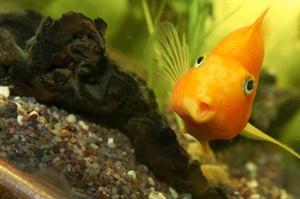| Complexity level: | 6 |
| Project cost ($): | 80 |
| Time required: | 1 hour to prepare, 7 days for observation |
| Material availability: | May be acquired from a pet store |
| Safety concerns: | None |
Hypothesis
The Elodea plant will grow faster in the aquarium with goldfish. The greater the number of goldfish, the better the rate of growth.
Overview
Plants in an aquarium
Aquatic plants add more natural beauty to a fish tank. They also help clean the water and reduce the growth of algae. However, conditions in the aquarium must be suitable for both fish and plant. The types of plants that can be introduced into an aquarium include rooted plants and floating plants.
Fish feed and produce waste daily. Aquariums normally have filters which help to clean and remove some of this waste from the water. Most of this waste is in the form of nitrates and nitrites. They are the same nutrients required by aquatic plants to grow. Therefore, having more plants in an aquarium can help to lower nitrate levels in the water. This also means less algae growth and less frequent cleaning of the tank.
The gills of fishes absorb oxygen from the water and produce carbon dioxide. Plants living in the water need the carbon dioxide for photosynthesis and growth. Aquatic plants produce oxygen which is needed for the fish’s respiratory function. Plants in the aquarium are also used as food and as places for fish to hide. This symbiotic relationship is beneficial to both fish and plants.
Scientific Terms
Materials
The materials required for this science fair project:
- 12 Elodea plants
- 4 fish tanks of the same size
- 16 goldfish
- Enough water to fill 4 fish tanks
- A pack of fish food
- 4 aquarium filters
- 4 aquarium lights
- 1 meter-long ruler
Procedure
1. For this science fair project, the independent variable is the number of goldfish in the tank i.e. none, one, two and three goldfish. The dependent variable is the average growth of the Elodea plants. This is determined by measuring and calculating the average height of the plants after 7 days. The constants (control variables) are the size of the aquarium, the amount of water in the aquarium and the amount of light received by the plants.
2. 4 fish tanks are filled with the same amount of water. The aquarium lights and filters are installed into the 4 fish tanks.
3. The height of the 12 elodea plants are measured using a ruler. The plants are separated into 4 bunches of 3 plants each. The average height of the plants in each group are calculated and the results recorded in the table below.
4. One bunch of Elodea plants are placed in each of the 4 aquariums. The 1st aquarium will not have any gold fish. The 2nd, 3rd and 4th aquarium will each have one, two and three goldfishes. The aquarium filter is switched on. The aquarium light is left on for 10 hours a day.
5. After 7 days, the Elodea plants are removed from the aquarium and their average heights calculated again. The results are recorded in the table below.

Results
It is observed that the Elodea plants grew faster in the fish tanks that contained goldfish.
| Number of goldfish | None | 1 goldfish | 5 goldfish | 10 goldfish |
| Initial elodea length (mm) | 97 | 99 | 96 | 96 |
| Final elodea length (mm) | 112 | 121 | 129 | 132 |
| Average growth (mm) | 15 | 22 | 33 | 36 |
The graph below represents the results of our science project.

Conclusion
The hypothesis that the Elodea plant will grow faster in an aquarium containing goldfish, is correct.
Growing aquatic plants in a goldfish tank adds beauty to the aquarium. They also help to remove ammonia and nitrate waste produced by the goldfish. However, it is important to choose the right type of aquatic plants for the goldfish. The best aquatic plants for goldfish are ones that can withstand nudges from goldfish and those with strong roots. Otherwise, aquatic plants that do no thrive will decay and rot and will adversely affect the quality of the water in the aquarium.
Also consider
The science fair project can also be repeated by using other types of aquatic plants like the Anubias or Sword plant.
Try and repeat the experiment by using different types of fish (eg. Parrot fish).
References
Plants in a goldfish aquarium - http://www.desktopgoldfish.com/goldfish-aquarium-plants.php
Why keep life aquatic plants? - http://www.aquariumfish.net/catalog_pages/plants/plant_advice.htm

